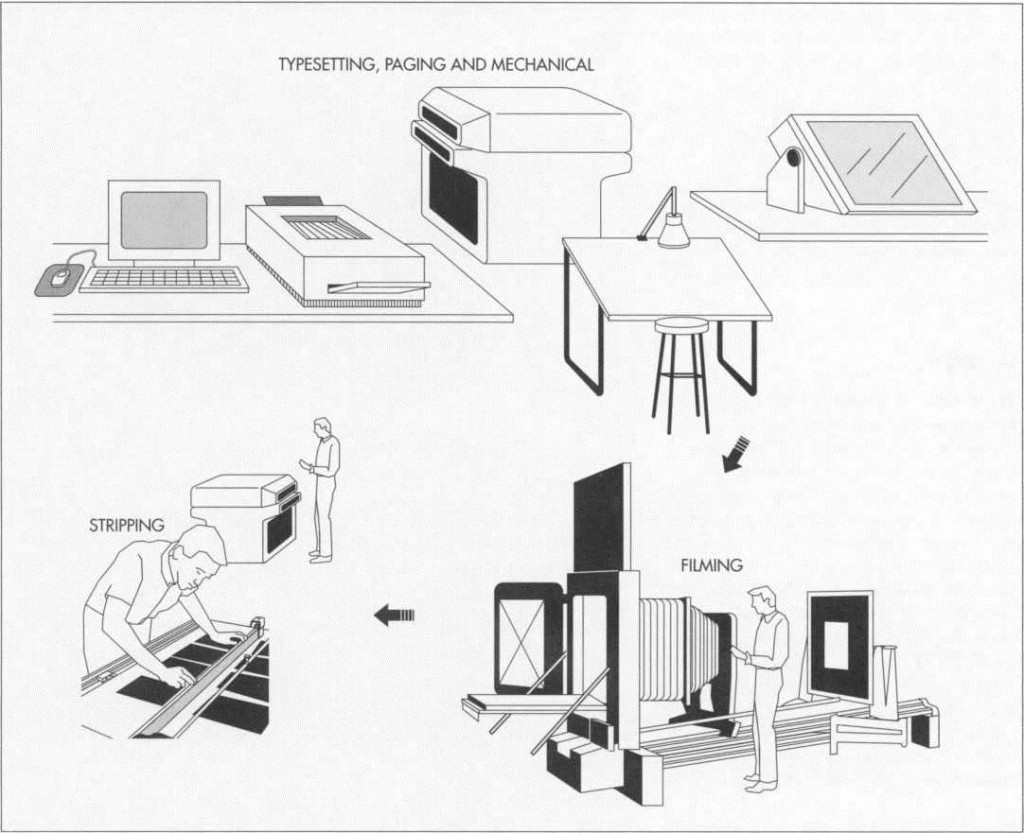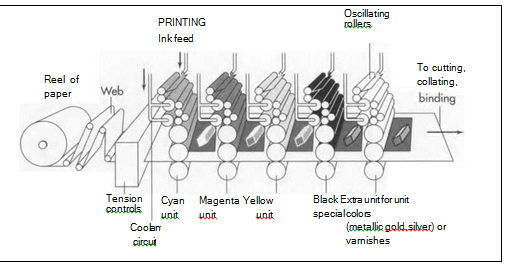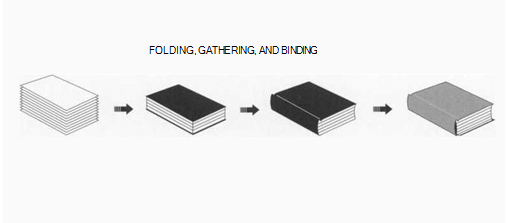Background
A book can be broadly defined as a written document of at least 49 text pages that communicates thoughts, ideas, or information. Throughout the ages, books have changed dramatically, assuming a number of different forms. To a great extent, the evolution of the book has followed the expansion of communication forms and methods and the ever- increasing demand for information.
The first known forms of written documentation were the clay tablet of Mesopotamia and the papyrus roll of Egypt. Examples of both date back as early as 3000 B.C. Independent of these developments were Chinese books, made of wood or bamboo strips bound together with cords. These books dated back to 1300 B.C.
Modern book production came about as a result of the invention of printing press. Although the invention of printing most likely occurred earlier in China as well, the introduction of movable type and the printing press to Europe is credited to Johann Gutenberg of Germany. Gutenberg, in collaboration with his partners Johann Fust and Peter Schoffer, printed a Latin Bible using a hand printing press with movable lead type by about 1456. Each individual letter of early hand-set type was designed in a style closely resembling script or hand lettering. Thus, the first books printed in Europe appeared much like books produced by scribes. Books printed in the fifteenth century are now called incunabula, a word derived from the Latin word for cradle. In 1640, Stephen Day printed the first book in North America, in Cambridge, Massachusetts.
Because the printing press and moveable type mechanized the book production process, books became available in greater numbers. By the nineteenth century, however, the demand for books could not be met quickly enough by the process of hand printing. Printers developed larger presses to accommodate larger sheets of paper and/or the newly invented continuous rolls of paper. These improvements allowed printers to produce books at a much faster rate. During the decades of the mid-1800s, further progress was made, including the invention of the papermaking machine (1820s), binding machinery (1860), and the cylinder press (1840s); later, the linotype (invented in 1884), cast type by line rather than by individual letter.
Book production in America and throughout the industrialized world has flourished and expanded during the twentieth century. Important advances in printing, such as the introduction of the offset printing press and computerized typesetting, have made mass production more economical. The development of the paperback book, which was introduced in the 1940s to provide a less expensive alternative to the traditional hardback book, has also made books more accessible to the public. While the invention of other forms of media, such as radio and television, has had an adverse impact on reading in general, books remain the primary source of knowledge throughout most of the world.
Raw Materials
Books are made from a variety of different coated and uncoated paper stocks that differ in weight and size. In addition, different color inks may be used. Also, while front
and back covers are generally made from a heavier stock of paper, they will vary in terms of weight. For example, hardback books have a durable cardboard stock cover while paperback books are made from a thinner paper stock. Usually, cover stocks are coated with different colors or designs.
Since the nineteenth century, book production has entailed the use of sophisticated machinery, including typesetting machines, a web or sheet-fed printing press, and book binding machines.
Design
The process of designing a book is ongoing throughout the stages of production. Initially, the author, in conjunction with an editor and book agent, will consider elements of design that pertain to the scope and purpose of the book, the desired approach to the subject matter, whether illustrations should be used, and other issues such as chapter headings and their placement. In determining those elements, the intended audience for the manuscript will be considered, along with accepted editorial standards. Other design considerations include whether a book should have a preface, a foreword, a glossary to define specific terms, an index to reference key words and concepts, and an appendix of supplementary material.
Once the book manuscript is written, editors and authors must refine the manuscript to attain a final edited version prior to production. In most cases, this involves a process of reviewing, editing, proofreading, revising and final approval. After such manuscript design factors are completed, editors and art directors will determine the following features:
• page size and style
• typeface size and style
• the type and weight of paper for the text and cover
• use of color
• presentation of visuals/illustrations in the text, if needed
• cover art/illustrations
Since the days of Johannes Gutenberg and well into the twentieth century, printers have considered themselves a special lot. They needed to be literate to sell type by hand, and they needed physical strength and endurance to operate a hand press Because their work pull them into contact with politicians, and community leaders, they often had social contacts beyond hose commonly available to workers. Because they had constant access to idea* and information they were generally considered to be learned individuals. Sometimes called the intellectuals of the working class, printers were distinguished by the fact that their work was a unique combination mental and manual labor like most skilled tradesman, nineteenth-century printers developed o special language for their work There were, of course, technical terms naming processes or tools. But much of the language, drawing on Anglo-European traditions dealt with social relationships Knowledge of this language was part at the training of an apprentice and separated the “fraternity” from the uninitiated. The youngest apprentice was called a “devil,” reflecting his low Status, responsibility for menial work and propensity far getting dirty. Workers “je’ffed,” or used type as dice, to see who got certain work, who paid far drinks, or who laid on a night so that a “sub” (substitute) could get some work. The workers In an office would unofficially organize themselves into a “chapel” and elect a “chairman” or father .” These traditions eventually evolved into the union shop and union steward
William S Prgtzer
(The first step in book production is typesetting, which increasingly is being done with desktop computer programs. With a computer, the proper software, and a laser printer, manuscript can be typeset that has the same quality as that produced by traditional typesetting methods. Once typeset, the mechanical or “camera-ready cop/’ of the manuscript is sent to a printer. This vendor then photographs the pages to produce page negatives. Next, these negatives are stripped by hand onto large flat sheets known as “goldenrods,” and the golden- rods are exposed with ultraviolet light. This results in “blueprints,” a positive reproduction of the book that is then checked for accuracy.)
The Manufacturing Process
After the book is written and appropriate design elements are agreed upon, book production can begin. The first stage is type setting, in which the actual text is converted into the appropriate typeface style (known as font) and size (known as point size). After the typeset version of the book has been reviewed and any necessary changes made, it is ready for printing and binding, in which the actual pages are printed and bound together with the cover, resulting in a finished book. The typesetting and printing— “printing” consists of filming and all subsequent steps—are typically done not by the publisher but by specialized vendors.
Typesetting
1 First, the manuscript is converted into the desired font and point size. If the manuscript has not been completed on a computer, it must be typed into a computer by the type-setter. If it is already in electronic form, how- ever, the typesetter simply has to make programming changes to convert the manuscript into the proper style. The result is generally (but not always; see step #3 below) a galley of the text. A galley form of manuscript consists of long pages of text in a single column. The galley includes the proper typeface, but the proper pagination still must be worked out.
2 Galleys are then proofread and edited for errors by the publisher. This stage is particularly important if the manuscript has been typeset (typed) from a hard copy of the text. If the manuscript was typeset from a computer disk, most of the errors should have already been corrected during a review of the manuscript. The single-column format of galleys facilitates the proofreading Pages and mechanical
3 After galleys are thoroughly proofed and edited, pages (or lasers) are produced. An exact layout of typeset pages but usually printed on standard typing paper, pages are also reviewed for accuracy by the publisher. Some books skip the galley stage and proceed directly to pages. Once any necessary changes have been made, the typesetter then produces a mechanical of the typeset pages. Also called camera copy, the mechanical is printed on high-quality paper that is suitable for filming, the first stage in the printing process. The work of the typesetting vendor—if different from the publisher—is now done.
Filming
4 The typeset mechanical now goes to the printing and binding vendor. First, each text page, including line drawings, is photographed (or shot) using a large camera to produce page negatives. These negatives are the opposite of what will actually print. In other words, the text and photos will appear backward in negative form. Negatives are then checked to make sure there are no blemishes present. While printed words and line drawings are all one shade of black, photographs have many shades from palest gray to deepest black and must be filmed using a special process to maintain these shades. The process converts the shades into black and white dots—very light areas have many dots, while darker areas have fewer dots. The converted photographs are known as halftones. If the book will have more than one color of ink, a separate negative for each color is made. For color photos, for instance, four negatives are generally used: cyan, magenta, yellow, and black. For this reason, books with color will have negative overlays (one negative overlay for each color). Because of the added overlays, a book printed in more than one color involves additional preparation and cost.
Stripping
5 The negatives are then taped or “stripped” into their proper place onto a large sheet called a goldenrod or a flat. Each flat holds 32 or 64 pages, and enough flats are used to equal the number of pages in the book. Strippers examine each finished flat on a lineup table to ensure that text and illustrations are properly lined up and in sequence. (The book pages are not lined up in consecutive order on the flat, and in fact some of the pages are placed upside down. Such placing is necessary because the finished paper version of each flat will be folded several times; once the flat is folded, the 32 or 64 pages will be in the proper order. This placement method is known as imposition.) To make this examination process easier, the lineup tables are equipped with a fluorescent light that shines up through the negatives, so it is easier for the stripper to read and align the text.
Blueprints
6 To make sure the book is progressing properly, a proof of each flat is made by shining ultraviolet light through the negatives to expose their images onto a special light-sensitive paper. The resulting pages are called blueprints (or silverprints, bluelines, or dyluxes) because the paper and ink are blue or silver in appearance. The blueprints are then checked carefully by the publisher. If an editor or art director finds an error on a blueprint or decides to make a change, the page in question has to be rephotographed. The new negative will then be stripped onto the flat.
Plate making
7 After final approval, each flat is photographed, with the negatives being exposed onto (or “burned” onto) a thin sheet of aluminum called a plate. The sections of the plates that contain text and illustrations are then treated with a chemical that attracts ink, thereby ensuring that the text and illustrations will print when on press.
Printing
8 The plates are then sent to press. If printing in only one color, each plate will require only one pass through the press. If printing more than one color, an additional pass will be required for each color. For example, if two colors are used, the paper is fed through the press twice.
There are three main printing processes used in book production: offset lithography, letterpress, and gravure. The process used depends less on quality differences than on economic factors such as availability of machines, number of books being printed (the print run), and the speed of delivery. Presses are either sheet-fed (single sheets of paper are fed through) or web-fed (huge rolls of paper are unwound and run through).
(Printing is often done on an offset lithography printing press, in which the paper is fed through rolls that are exposed to the proper ink. If colored ink is necessary, either for text or for photographs, each of the four major colors is offset onto its own set of rollers.)
Binding
9 After the sheets are printed and dry, they are delivered to the bindery. While many large printing companies have their own binderies, other smaller printers must send the printed sheets to a outside bindery. At the bindery, the flats are folded and collated into book signatures—properly folded 32- or 64- page sections—that are then bound in proper sequence. All of these functions are automated.
1 f \ Book binding also involves sewing
I the signatures together, gluing the spine, and inserting lining and trimming the edges. The amount and type of binding depends on the type of book (paperback or hardback) and its size. In the final step, the book is “cased in,” or enclosed in a cover.
Quality Control
To help ensure that a quality product is produced, print shops conduct a number of periodic checks. In addition to checking blueprints for accuracy, printers will pull a press proof, or sample, before the print run is begun. If certain areas of the proof are too light or too dark, adjustments to the press may be required.
After the book signatures are sewn together, the print shop will spot-check them to make
sure they have been folded and sewn correctly. They will also check to see if the book covers are properly bound to prevent the books from deteriorating with use.
Some of the instruments used to control quality include densitometers and colorimeters, both of which are used to evaluate color printing processes; paper hygroscopes, which measure the moisture balance of paper against the relative humidity of printing rooms; and in kilometers, which measure the quality of the ink to be used in printing.
The Future
Book production has remained much the same since the early twentieth century, except for changes in typesetting. While dedicated typesetting machines (linotype or monotype) have been standard equipment in print shops and typesetting businesses since 1900, desktop publishing on microcomputers has become a cost-effective alternative. With the proper typesetting software and a laser printer, users can generate text, insert graphics, and create layouts and page designs that are as sophisticated and detailed as those produced by traditional typesetting machines. As a result, authors, publishers, print shops, and virtually any other business have been able to set type and perform page layout and design on microcomputers. Furthermore, depending on the resolution and quality of the laser printer, users can create type that a printer can use to shoot a negative. Such type is referred to as camera-ready.
In addition, desktop publishing accessories such as scanners and graphics software allow users to insert still more computer graphics and scan in photographs, hard-copy graphics, and text into their desktop system.
For book production, many authors, publishers, and design shops now have their own desktop publishing equipment, allowing them to give printers camera-ready copy. If they do not have laser printers with sufficient print-quality resolution, they can simply give the printer the book in disk form and have the printer run the type out on a laser printer with high resolution. Either way, desktop publishing gives the user more design control and cuts down on production costs.
Because desktop publishing is relatively new, changes and enhancements continue to make the systems more user-friendly. As more people gain access to such systems, book publication and publishing in general will see more widespread use of desktop publishing in the future
Where To Learn More
Books
Foot, Miriam. Studies in the History of Bookbinding. Ashgate Publishing Co., 1992.
Harrison, Thomas. The Bookbinding Craft & Industry. Garland Publishing, Inc., 1990.
Hollick, Richard. Book Manufacturing. Cambridge University Press, 1986.
Lyman, Ralph. Binding & Finishing. Graphic Arts Technical Foundation, 1993.
Matthews, Brander. Bookbinding Old & New. Garland Publishing, Inc., 1990.
McMurtrie, Douglas C. The Book: Story of Printing & Bookmaking. Dorset Press, 1990.
Pocket Pal: A Graphic Arts Production Handbook. International Paper, 14th ed., 1989.
Poynter, Dan. Book Production: Composition, Layout, Editing & Design—Getting It Ready for Printing, 3rd ed. Para Publishing, 1992.
Periodicals
Angstadt, Richard. “Why Typesetting Isn’t as Good as It Should Be: An Experienced Typesetter Laments the Communications Problems in a Changing Industry,” Publishers Weekly. September 7,1990, p. 60.
Monkerud, Don. “Plate Full of Promises: Direct-to-Plate Technology Offers Faster and Cheaper Short-Run Color Printing,” Publish. January, 1993, p. 48.












